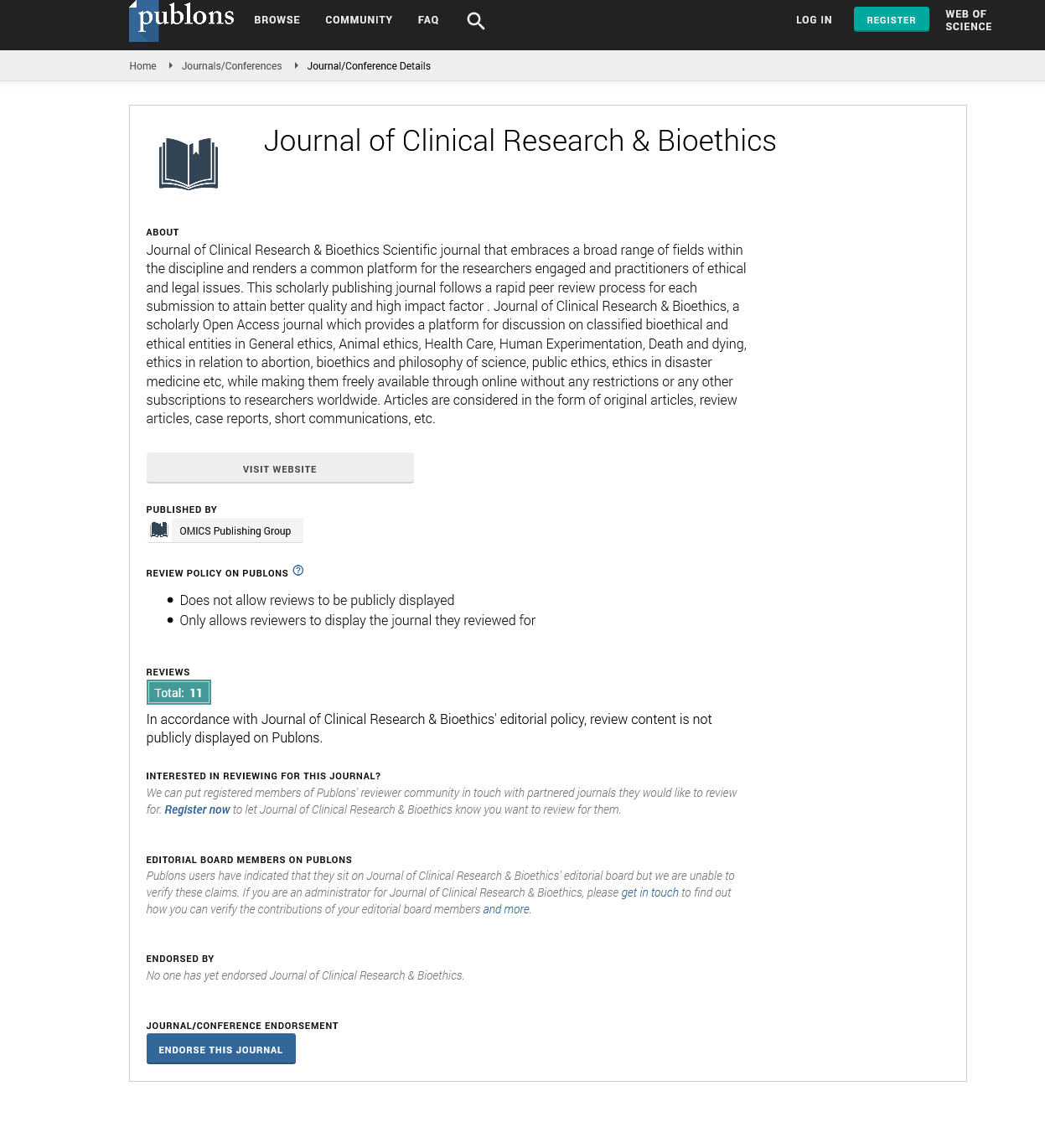Indexed In
- Open J Gate
- Genamics JournalSeek
- JournalTOCs
- RefSeek
- Hamdard University
- EBSCO A-Z
- OCLC- WorldCat
- Publons
- Geneva Foundation for Medical Education and Research
- Google Scholar
Useful Links
Share This Page
Journal Flyer

Open Access Journals
- Agri and Aquaculture
- Biochemistry
- Bioinformatics & Systems Biology
- Business & Management
- Chemistry
- Clinical Sciences
- Engineering
- Food & Nutrition
- General Science
- Genetics & Molecular Biology
- Immunology & Microbiology
- Medical Sciences
- Neuroscience & Psychology
- Nursing & Health Care
- Pharmaceutical Sciences
Perspective - (2025) Volume 16, Issue 6
The Ethical Dimensions of Informed Consent in Clinical Research
Sofia Almeida*Received: 30-May-2025, Manuscript No. JCRB-25-29548; Editor assigned: 02-Jun-2025, Pre QC No. JCRB-25-29548 (PQ); Reviewed: 16-Jun-2025, QC No. JCRB-25-29548; Revised: 23-Jun-2025, Manuscript No. JCRB-25-29548 (R); Published: 30-Jun-2025, DOI: 10.35248/2155-9627.25.16.538
Description
Informed consent is one of the most fundamental principles of ethical clinical research, serving as a safeguard for human dignity, autonomy, the right to make independent decisions about participation in scientific studies. It is not merely a procedural requirement but a cornerstone of bioethics, reflecting the shift from paternalistic models of medicine to a framework cantered on respect for individual autonomy. Despite being widely acknowledged as essential, the practical implementation of informed consent is fraught with ethical complexities that challenge researchers, regulators, ethicists worldwide.
At its core, informed consent requires that participants are provided with adequate information about the nature, purpose, risks, benefits, alternatives of a study, that they voluntarily agree to participate without coercion or undue influence. This process is rooted in historical lessons from unethical research practices, such as the Tuskegee syphilis study and Nazi medical experiments, which demonstrated the devastating consequences of exploiting vulnerable individuals without their knowledge or agreement. Modern research ethics frameworks, such as the Declaration of Helsinki and the Belmont Report, emphasize the central role of informed consent in protecting participants. Yet, while the principle is straightforward, its application in realworld research settings is far more complex. One of the major challenges is ensuring that participants truly understand the information presented to them. Research protocols are often highly technical, filled with medical terminology and complex statistical concepts that may be difficult for lay participants to grasp. Even when consent forms are simplified, they may remain overwhelming due to their length or legalistic style. In such cases, consent risks becoming a symbolic signature rather than a meaningful process of understanding.
The concept of comprehension also varies depending on cultural, educational, social contexts. In low-resource settings, participants may lack basic literacy, making it difficult for them to read or interpret consent documents. In such cases, verbal consent or the use of visual aids may be necessary to convey essential information. However, this raises questions about whether comprehension can ever be fully achieved in populations where medical concepts are unfamiliar or trust in researchers is fragile. Ethicists argue that researchers have a responsibility to adapt the consent process to the needs of participants, ensuring that information is both accessible and culturally relevant.
Voluntariness is another critical element of informed consent. Participants must be free to decide without coercion, but subtle forms of pressure often exist in clinical research. For example, patients may feel obligated to participate in trials if their physician is the researcher, fearing that refusal might compromise their care. Similarly, financial incentives, while sometimes necessary to compensate participants for time and inconvenience, may become undue inducements that cloud genuine decision-making. Striking the right balance between encouraging participation and preserving autonomy is a delicate ethical task.
The issue becomes even more complicated when research involves vulnerable populations, such as children, individuals with cognitive impairments, or economically disadvantaged groups. In such cases, obtaining genuine informed consent may not be possible, requiring alternative safeguards such as parental permission, assent procedures, or oversight by independent guardians. These measures aim to ensure that participation is ethically justifiable while acknowledging the limitations of autonomy in certain populations. However, they also raise further questions about how much weight should be given to the voices of vulnerable participants themselves, particularly in pediatric research where children may wish to express preferences about their involvement. Another ethical tension lies in the evolving nature of research itself. In long-term clinical trials, circumstances may change, new information may emerge about risks or benefits. Informed consent is not a one-time event but an ongoing process that requires continuous communication with participants.
Researchers must update participants when new findings arise and give them the opportunity to reaffirm or withdraw their consent. Failure to do so undermines the ethical basis of the research and risks eroding trust. In recent years, the rise of bio banking and genomic research has introduced additional complexities. Participants are often asked to consent to the storage and future use of their biological samples for unspecified research purposes. While this advances scientific progress, it raises questions about whether participants can give truly informed consent for unknown future studies. Models such as broad consent or dynamic consent have been proposed to address this challenge, allowing participants to either give general permission for future use or to remain engaged with researchers through ongoing digital communication. Both approaches highlight the need for flexibility and respect for evolving participant preferences.
Citation: Almeida S (2025). The Ethical Dimensions of Informed Consent in Clinical Research. J Clin Res Bioeth. 16:538.
Copyright: © 2025 Almeida S. This is an open-access article distributed under the terms of the Creative Commons Attribution License, which permits unrestricted use, distribution and reproduction in any medium, provided the original author and source are credited

